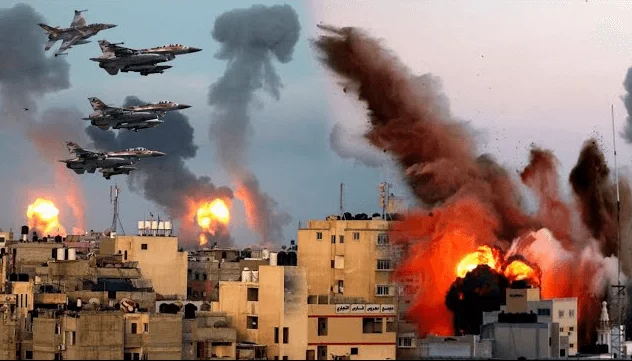How Israel Chooses Targets for Airstrikes in Gaza? It is mostly intelligence-based strikes gathered from different means such as on-ground and from aerial surveillance.
Note: The information presented here is for a general understanding. It is not the understanding or belief of the platform and must not be considered 100% correct. Please verify from your own sources.
Keep reading till last.
How Israel Chooses Targets
Israel claims that it meticulously selects targets for airstrikes, employing a comprehensive process that emphasizes precision and the avoidance of civilian casualties. This procedure involves intelligence gathering, legal scrutiny, and compliance with international laws, and it has evolved over time to prioritize minimizing harm to non-combatants. But mounting civilian casualties in airstrikes raises serious questions in this regard.
Read More: Iron Sting Weapon System: A Comprehensive Overview
Following is the basic understanding from the Israeli perspective, and the reality might be different, we advise verifying the below-mentioned information from your own sources:
1. Intelligence Gathering: Israel’s intelligence agencies gather extensive data on potential targets, utilizing advanced technologies. For instance, Israel operates a fleet of sophisticated drones, including the Heron TP, capable of conducting long-range surveillance and reconnaissance.
Read More: Israel-Palestine Conflict
2. Verification: Prior to approving an airstrike, the intelligence data undergoes a rigorous verification process. Israel has developed advanced algorithms and software that aid in identifying the potential presence of non-combatants near a target, reducing the risk of collateral damage.
3. Legal Review: The Israeli military engages its legal experts to scrutinize the proposed target to ensure it complies with international laws. Israel’s commitment to upholding international legal standards is reflected in its active participation in organizations like the International Committee of the Red Cross.
Read More: Israel Hit Hospital in Gaza: 300 Killed Instantly
4. Decision-Making: High-ranking military officials, often including the Chief of Staff, make the final decision on whether to proceed with an airstrike. Israel’s transparent decision-making process helps ensure accountability and compliance with international humanitarian laws.
5. Warning: Israel’s military employs a combination of tactics to provide warnings to civilians. Allegedly, during the 2014 conflict in Gaza, the Israeli military made more than 167,000 phone calls to warn civilians of impending airstrikes, demonstrating a commitment to protecting non-combatants.
Read More: Israel-Saudi Ties & Palestine
6. Precision Munitions: Israel primarily uses precision-guided munitions (PGMs) designed to hit the intended target accurately while minimizing harm to nearby civilians. According to the Stockholm International Peace Research Institute (SIPRI), Israel is among the world’s leading exporters of PGMs, underscoring its commitment to minimizing collateral damage.
Read More: Iron Sting Weapon System: A Comprehensive Overview
7. Post-Strike Assessment: Following an airstrike, Israel conducts a thorough assessment to determine the mission’s success and any unintended damage. These assessments inform ongoing efforts to improve targeting procedures and reduce civilian casualties.
Read More: Israel Expands Evacuations Amid Lebanon Border Clashes Mounts
Conclusion: How Israel Chooses Targets for Airstrikes in Gaza?
While precise statistics on the success and accuracy of Israel’s airstrikes are often classified, the commitment to minimizing civilian harm is evident in the evolving tactics, training, and technologies employed by the Israeli military.
It is important to note that Israel often operates in densely populated areas, increasing the complexity of avoiding civilian casualties. Despite the challenges, Israel remains dedicated to its goal of conducting precise and lawful airstrikes.
The process of target selection for airstrikes is a critical component of Israel’s overarching military strategy, aimed at safeguarding its population while adhering to international legal standards and maintaining respect for humanitarian principles.
Note: The information above might not be 100% correct. Please verify from your own sources.
For more news, please visit Munafa Marketing.




